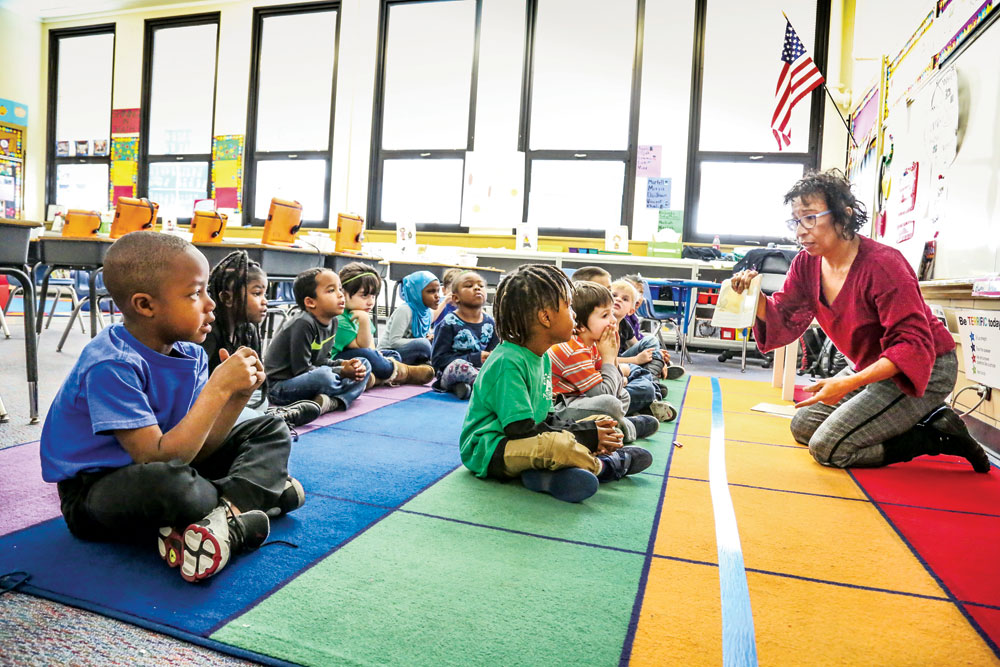
Ashley Principal Zachary Rahn talks about data from the School Performance Framework that he and Ashley staff can use to identify weaknesses and implement changes to improve the school.
On last year’s early literacy test for first to third graders, Ashley ranked in the top ten elementary schools in the district—alongside many affluent schools with far fewer “academic gap” students.
The Front Porch made a color-coding error on Ashley Elementary School’s status (achievement), incorrectly coloring it red rather than yellow in the School Performance Framework (SPF) chart* we printed last month. Our error brought attention to the impact these color codes have on schools—and the kind of information a parent doesn’t learn from the SPF system of color-coding. We discovered that initial impressions of a school based solely on the SPF chart can change dramatically with a deeper look at the data behind it.

Kindergarten teacher Margarita Taylor works with her class on reading.
On Ashley’s test of early literacy for kindergarten through grade three last year (the Istation test), they were in the 87th percentile, ranking tenth in all of DPS elementary schools using that test. Ashley was in the same pool as neighboring affluent schools with far smaller numbers of at-risk students. “In comparison to schools that are not similar to us (their numbers within those groups are less than ours), we’re outperforming them by significant numbers,” says Ashley Principal Zachary Rahn.
This year DPS raised the level at which students are considered proficient on the early literacy Istation test for grades 1 – 3. Data showed that students who tested proficient on Istation early literacy test were not proficient on the state test that starts in grade 3. Vice Principal Kali Gonzales says Ashley staff could see the Istation “aim lines” were too low, and they set their own higher aim lines last year. That has paid off on monthly assessments this year. Under new scoring standards, Ashley started the year at 37, when the district overall was at 30. “We’ve made consistent growth every month. In November, we’re at 50% and the district is at 26%,” she says.
“Last year we were measured on 27 different populations—boys, girls FRL etc. We went up in 26 of 27 measures.” Rahn says this data shows Ashley is serving all students. He also points out that they specifically track higher achieving students, and that sub-group also shows the growth reflected in other sub-groups.
Examining reasons for the red color-coding in Ashley’s Parent and Student Satisfaction category, Rahn says, “There’s good data for us as a school to unpack even as we’re disappointed in their responses.” The category compiles separate results for parent and students satisfaction and for attendance. Some categories were high—90% said, “My teacher cares about me.” But only 60% said, “When I do my work my teacher tells me what I did well and where I need to improve.” Fifth graders gave the lowest scores in this sub-category.
Gonzales says this student response enabled them to identify the need for clearer teacher communication. They have since implemented a new system for students to better track where they’re doing well and where they need to improve.
“It (the SPF) can be very confusing. I know a lot of families and that’s the reason they pick a school,” says Ashley parent Soren Gall “…it’s almost better to have your child in a more diverse setting while they’re young because they can learn to appreciate different cultures and different individuals. That’s huge to me…If you’re not a green or a blue, some people just totally disregard you…”
Rahn points out that Ashley was just three points from being a green school in their overall rating this year. If not for the low rating from 5th graders and the attendance algorithm used last year (which is being changed this year), Ashley would have looked like the top row instead of the lower row.

It’s the same school with a couple of relatively small differences. But the resulting color changes greatly affect the perception of anyone who doesn’t dig deeper than the chart. Other schools would likely share similar stories with families that ask for more information.
“How do we do we create tools or systems that ensure increased levels of equity and show where we’re hitting the mark and where we’re not hitting the mark—in a non-punitive way?” asks Rahn.
*SPF Ratings
The SPF rates achievement, growth, parent and student satisfaction, and academic gaps (the difference in achievement between certain subgroups—like low-income students, students of color and English Language Learners—and the rest of the student population). Each category is rated separately, and each school gets an overall rating and color code based on a DPS algorithm that combines the separate scores. A school’s overall rating is the combined score, shown as a color and a rating level (the first two columns in the rows shown above). The colors resemble a stoplight with the addition of blue for “distinguished” schools. Green schools “meet expectations.” Yellow schools are “on watch.” Orange schools are “on priority watch.” Red schools are “on probation.”


0 Comments